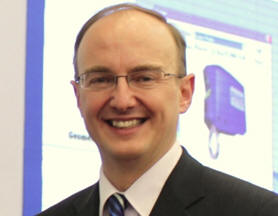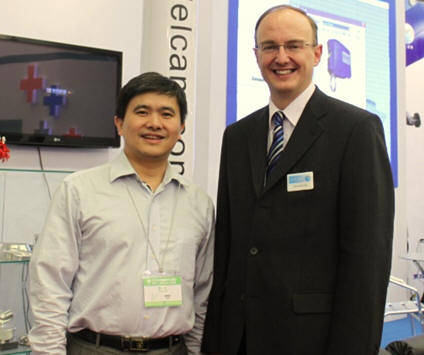Delcam, focus on machining better products
On May 12, 2010, at the Die & Mould China 2010(DMC2010)show, I interviewed Mr. Clive Martell, the managing director of Delcam, which is the largest independent CAM vendor globally. It is the second time that Clive visited China. He is very impressed with the rapid growth of Chinese economy and Chinese manufacturing. With the deep background of mechanical engineering and CAM technology, Clive is leading Delcam to realize sustainable growth globally and in China.

Mr. Clive Martell, the managing director of Delcam
Pei Huang: What types of new functions and new software will Delcam release on the Die and Mould China 2010 show?
Clive Martell: We released our latest PowerMILL version, PowerMILL 2010 at this show, which introduced some new strategies of 5 axles machining, rest material machining, corner clearance machining, etc, and the powerful function of using multi-processors.
Pei: Last year, global economy was greatly impacted by the recession. How about the growth status of Delcam globally and in China? Do you see the recovery trend this year?
Clive: Delcam has made excellent progress on our CAD and CAM products. As a result, our business has grown significantly over the years. At the end of 2008, we could see that with the economic recession going on, 2009 would be a very difficult year, but we are confident that with our customer base around the world, we could survive. In fact, we are very pleased that our turnover only decreased 3% in 2009. With the confidence, we did not make big restructuring and keep our team together. So, when the recovery is coming, we are at a very strong position. This year, we will see that in most part of the world, we will get 20% growth. Our Chinese market has increased about 30% compared with the same time of last year. We already see good growth in the market this year.
Pei: Delcam has several CAM products to serve different sectors of CAM market. Please introduce the growing status of these products.
Clive: We have four manufacturing software packages, and each with their own unique focus. PowerMILL is for high speed, 5 axles and high precision manufacturing, which is particularly fit for the high precision parts manufacture of the mold and die industry. FeatureCAM is used where the speed of programming is most important, and could get the feature of the parts to generate the very quick tool path, but not necessary the most optimized tool path. PartMaker is focusing on high production turning and turn-mill environment used by Swiss-type lathes to get minimize cycle time. For artist CAD/CAM, we have ArtCAM. So, our each software is focusing on different market which we are very strong in. PowerMILL is our best selling and fastest growing product. We also see good growth of FeatureCAM and PartMaker. This year, we released a new product, Delcam for SolidWorks, which takes our FeatureCAM technology to make a plug in software on top of SolidWorks. This software can extract the features defined in SolidWorks and use the feature recognition technology to indentify the features to generate the tool path automatically. It is integrated with SolidWorks very tightly and is very easy to learn for the SolidWorks users.
Pei: Will you also plan to release specialized CAM software for other CAD systems?
Clive: That’s possible in the future. We feel that SolidWorks is clearly a very successful design software, with open architecture to have plug in products, so we release the specialized CAM software for SolidWorks first. I think that this product has very big opportunity in global CAM market.
Pei: Delcam is focusing on CAM industry. How could Delcam realize sustainable growth on technology innovation and business?
Clive: Delcam is the largest and the most successful CAM focus organization in the industry. The positioning strategy is built really from our founding days to improve manufacturing capability through our CAM tools. Our mission statement is to be successful in global CAM market. We feel that there are still many opportunities in the traditional CAM market, such as tool, mold and die, aerospace and automotive industries to improve our market share, and we also find some new areas to grow, such as health care and dental market. We will release new application in these new markets.
In the future, we will continue to apply multi cores of CPU and the cluster of computers to improve the efficiency of our solutions. We have the largest R&D team of CAM software in the world so that the team could share the new modules fit for the specific CAM market and get rapid progress. Each of our CAM software products will focus on meet unique CAM requirement to get the highest efficiency. We will also use our core technology in different application areas, such as Delcam for SolidWorks and our dental CAM solution.
Pei: Now, more and more manufacturers begin to use composite material. Does Delcam offer the manufacturing functions for composite material?
Clive: Our strategy of the machining the composite material is to use adaptive manufacturing which means we will use the probe to get the actual geometry of the component to be machined, rather than use the normal geometry of the component. Use the combination of our inspection product and 3D machining technology, we can provide a very efficient workflow for composite material machining. The technology of machining of composite material in still in the early days, and we will see a lot of demand on that area.
Pei: In your view, what are the growing drivers of global CAM market?
Clive: The global CAM market has not grown very rapidly, but it still grows. The growth of CAM market is related to the improvement of manufacturing capacity. We have seen the trend of traditional mold and die industry moving to Asia and South America. CAM market is a very fragmented market with a lot of opportunities. The growth of Delcam comes from our existing products, new products based on our technology, and new application areas, such as the manufacture of artificial tooth.
Pei: How about the trend of CAM technology? Will there be any disruptive innovation in CAM technology?
Clive: The answer is definitely yes. The innovation will be driven by 64 bit architecture, increase memory space, multi CPU available, which means that we can break the task into multi processors, we can start to use some new algorithms which is traditionally not possible on 32 bit architecture, and we can also try to conduct what-if scenario to predict what the users might be doing next to provide the right functionality. So, with the new generation hardware platform, we can finish many tasks in more cost effective way. Of course it will still take times for these technologies to be evolved, but absolutely, the change will occur in the next few years.
We are also improving the automation of CAM software, developing more intelligent machining strategies, producing more challenging parts, and integrating measuring with the machining process, so that we could have the best control with the process.
Pei: Are there any improvement with your simulation functions of machine tools?
Clive: Not only our software could simulate the machine tools, but could also simulate the robotics. We have been doing more works in the surface finish prediction, and we will continuously improve the functions in simulation area.
Pei: What’s improvement do you realize with the Delcam CAD software?
Clive: We released a new version of PowerShape with Parasolid kernel so that we could use solid modeling together with our traditional surface modeling functions. We also improve the tool design functions to help engineers design inject mold and electrode. It could provide the right process to design these products.
Pei: What’s your view about the biggest difference of Chinese manufacturers and western manufacturers?
Clive: My impression from the visit is that there are already some world class manufacturers in China. Probably the most striking difference is that the scale of Chinese manufacturers in tools, mold and die industry is often much larger than the traditional western manufacturers. We have some very large customers in mold and die industry in China.
Pei: Many Chinese manufacturers just started up for several years, so that they still need to improve in many areas. How could Delcam help Chinese manufacturers improve their innovation skills?
Clive: Delcam has the largest CAM software development team and we invest heavily in R&D every year. We are providing world class CAM products combined with the expertise to implement the products to make sure our customers could use the best practice. So, not only do we provide products, but also we provide training and service so that our software can offer real value to our customers. We are continuous to improve our software and technology to meet the always changing needs of our customers.
Pei: How does Delcam cooperate with the universities around the world and in China?
Clive: We have cooperation plans with education systems in most of the countries we operate in order to ensure the students are trained by current technologies rather than yesterday’s technology. In China, we work with over 40 universities, and we also support the national NC competition this year.
Pei: In China, most manufacturers still do not buy maintenance service. Do you have any plans to improve your maintenance revenue?
Clive: It is a journey that the vendors could improve the technology so that the customers could apply the best technology through investing on the maintenance service of the products. However, it is interesting that in different countries people have different view about maintenance. In Germany, the ratio of purchasing maintenance is probably highest in the world. Most of successful and productive companies recognize that they will not just buy the software but they need to invest on the software continuously to make sure they can get the best usage of the products. In lower labor cost countries, companies are more reluctant to invest on maintenance service. In many companies, they have budgets to purchase capital equipment but do not have the budgets in invest on maintenance of ongoing software, so, the budget is also an issue. Right now, the maintenance revenue of Delcam is accounted for 35% of the total revenue.
About Mr. Clive Martell:
Mr. Clive Martell joined Delcam in 1982. He was appointed Marketing Director in 1994 and was responsible for strengthening the marketing team. Mr Martell became Managing Director of the UK Division in 1996 and responsible for European Subsidiaries in 2001. Clive Martell became Group Operations Director in April 2008 before becoming Managing Director in August 2009. Mr Martell is a Chartered Engineer with a Bachelors degree in Production Engineering and a Masters degree in Machine Tool and Manufacturing Technology from the University of Birmingham.

Picture of Clive Martell and Pei Huang on DMC2010
For the Chinese version, pleases visit: http://www.e-works.net.cn/interview/leader_295.htm
Editor: Sophie Shi ss@e-works.net.cn








